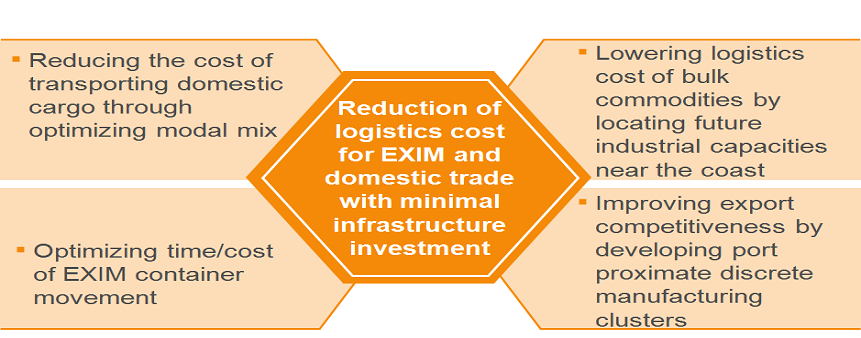Indian Economy
Potential of Lighthouses for Tourism: Sagarmala
- 12 Apr 2021
- 6 min read
Why in News
The Union Ministry of Ports, Shipping and Waterways seeks to develop 65 lighthouses on public-private-partnership mode. Odisha’s five lighthouses present huge potential for tourism.
- The Ministry wants to develop lighthouses as hubs of tourism under the Sagarmala project.
Key Points
- Five lighthouses of Odisha:
- ‘False Point’ island lighthouse: It is situated off the Kendrapara coast. It is the British era lighthouse and its location close to massive mangrove vegetation infested with crocodiles makes it an adventurous tourist place on the eastern coast.
- Paradip lighthouse: It also holds tourism potential because of its proximity to the port town and Cuttack and Bhubaneswar cities (100 km). It was commissioned in the 1980s.
- Gopalpur lighthouse: It is located in Ganjam district. If it is developed as a place of tourist interest, the Chilika Lake and the Gopalpur beach will be added attractions.
- Chandrabhaga lighthouse: It is 10 km from the world famous Konark temple. It had withstood the severity of cyclones such as the Super Cyclone (1999), Phailin (2013) and Fani (2019).
- Puri lighthouse: It is 4 km from the 12th century Shree Jagannath Temple, which is also a tourist place.
- Lighthouse Tourism in India:
- Number of Lighthouses: India has as many as 189 lighthouses dotting its vast coastline including the Andaman and Nicobar Islands in the Bay of Bengal and Lakshadweep Islands in the Arabian Sea.
- Objectives for Promoting Lighthouse based Tourism:
- To enhance & develop the existing lighthouses & its surrounding areas into a Tourism Destination, Maritime Landmark, and Heritage Precinct.
- To develop allied Maritime Infrastructure like National Maritime Museums & National Lighthouse Museums.
- To explore the possibilities of developing these projects under various modes including the possibilities of Public Private Partnership (PPP) by integrating commercially viable interventions at the feasible locations in order to make the project viable.
- Advantages:
- The advantages behind creation of lighthouses into a tourism product are that it shall help in attracting tourists from across the world & locally and thereby create a source of revenue for the government, employment opportunities for local people, increase in commerce through purchase and sale of goods and services, etc.
Sagarmala Project
- About:
- The Sagarmala Programme was approved by the Union Cabinet in 2015 which aims at holistic port infrastructure development along the 7,516-km long coastline through modernisation, mechanisation and computerisation.
- The vision of the Sagarmala Programme is to reduce logistics cost for EXIM (Export-Import) and domestic trade with minimal infrastructure investment.
- Sagarmala could boost India’s merchandise exports to USD 110 billion by 2025 and create an estimated 10 million new jobs (four million in direct employment).
- Components of the Sagarmala Programme:
- Port Modernization & New Port Development: De-bottlenecking and capacity expansion of existing ports and development of new Greenfield ports.
- Port Connectivity Enhancement: Enhancing the connectivity of the ports to the hinterland, optimizing cost and time of cargo movement through multi-modal logistics solutions including domestic waterways (inland water transport and coastal shipping).
- Port-linked Industrialization: Developing port-proximate industrial clusters and Coastal Economic Zones to reduce logistics cost and time of EXIM and domestic cargo.
- Coastal Community Development: Promoting sustainable development of coastal communities through skill development & livelihood generation activities, fisheries development, coastal tourism etc.
- Coastal Shipping & Inland Waterways Transport: Impetus to move cargo through the sustainable and environment-friendly coastal and inland waterways mode.
Public-Private Partnerships
- Public-private partnerships involve collaboration between a government agency and a private-sector company that can be used to finance, build, and operate projects, such as public transportation networks, parks, and convention centers.
- Financing a project through a public-private partnership can allow a project to be completed sooner or make it a possibility in the first place.
- Public-private partnerships often involve concessions of tax or other operating revenue, protection from liability, or partial ownership rights over nominally public services and property to private sector, for-profit entities.
- It can create complex principal-agent problems, such as corrupt dealings, pay-offs to political cronies, etc.
- Commonly adopted model of PPPs include Build-Operate-Transfer (BOT) ,Build-Own-Operate (BOO), Build-Operate-Lease-Transfer (BOLT), Design-Build-Finance-Operate-Transfer (DBFOT), Lease-Develop-Operate (LDO), Operate-Maintain-Transfer (OMT), etc.





